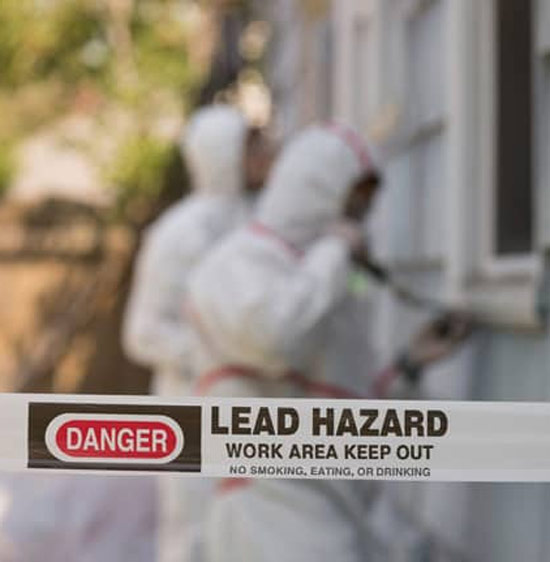DOH & HPD Lead Violation Removal NYC-- Professional Solutions for Compliance
DOH & HPD Lead Violation Removal NYC-- Professional Solutions for Compliance
Blog Article
Step-by-Step Refine for Effective Lead Violation Removal
Following this, adherence to government and state policies is paramount to formulating a reliable remediation plan. The real remediation requires competent employees to apply these strategies while purely adhering to safety methods. What occurs after the remediation is completed?

Discovery and Assessment
Detection and analysis are critical action in the removal of lead infractions. To make certain a reliable removal procedure, it is crucial to carry out a comprehensive assessment of the atmosphere where possible lead direct exposure exists. The preliminary stage of detection involves recognizing sources of lead contamination, which can be found in paint, water pipelines, soil, and dust. Utilizing innovative analysis devices such as X-ray fluorescence (XRF) analyzers and atomic absorption spectroscopy (AAS) can supply exact measurements of lead concentrations.
When detection is completed, a thorough analysis has to be carried out. This consists of reviewing the extent and intensity of contamination, in addition to identifying populaces in jeopardy, especially kids and pregnant women. Danger assessments frequently involve sampling and lab evaluation, environmental surveys, and health and wellness effect research studies. The collected data ought to be meticulously documented to sustain the development of an efficient removal strategy (Lead Violation Removal in NYC).
Moreover, it is vital to prioritize areas with the highest possible levels of contamination and those that present the best wellness threats. Efficient interaction with stakeholders, including homeowner, locals, and public health officials, is vital for ensuring that all events are educated about the findings and the subsequent actions required for remediation. This first detection and evaluation stage lays the foundation for a successful lead violation removal process.

Legal and Regulative Compliance
Navigating the landscape of legal and regulative conformity is a pivotal facet of successful lead offense removal. Compliance ensures not just the security of afflicted populaces yet also the reputation and lawful standing of the company liable for remediation.
State and regional laws can vary, frequently enforcing added responsibilities or more rigorous criteria. A detailed understanding of all appropriate legal frameworks is important. This involves precise paperwork of all removal activities to show conformity. Failing to stick to these regulations can result in severe penalties, consisting of large fines, lawsuit, and reputational damage.
Involving lawful professionals focused on ecological law can promote navigating these intricacies. Regular training and certification for all personnel involved in the removal procedure are additionally mandatory to guarantee adherence to security and regulatory criteria. By focusing on lawful and regulative compliance, organizations can efficiently mitigate threats and attain a successful remediation outcome.
Planning the Remediation
Effectively planning the remediation of lead offenses begins with a thorough analysis of the polluted website. This data-driven approach guarantees that remediation efforts are properly targeted and efficient.
As soon as the contamination is mapped, a danger assessment must be carried out to review possible health and wellness threats to humans and the atmosphere. Lead Violation Removal in NYC. This evaluation needs to think about aspects such as exposure pathways, population susceptability, and environmental effects. The insights gathered will create the basis for choosing a suitable remediation technique
Subsequently, setting clear, possible goals for the removal project is critical. These purposes ought to line up with governing standards and stakeholder assumptions to guarantee conformity and area approval. Establishing a detailed removal plan that details techniques, timelines, and source allocation will facilitate an organized strategy to the cleanup procedure.
Furthermore, it is vital to engage with stakeholders early and preserve transparent communication throughout the preparation stage. This includes notifying regional neighborhoods, obtaining essential authorizations, and coordinating with regulatory firms to make certain all lawful and step-by-step requirements are satisfied. A well-crafted remediation plan not just addresses the contamination properly however likewise builds count on and collaboration among all events entailed.
Implementing the Remediation
With a well-structured remediation plan in position, the focus moves to the real implementation of the remediation activities. This phase includes mobilizing the required resources, including competent personnel, specific devices, and premium products. Begin by plainly defining duties and obligations to guarantee liability and smooth sychronisation amongst team members.
This consists of setting up control locations to protect against lead dust and particles from dispersing, as well as using air filtering systems to maintain air top quality. Utilize techniques such as damp scraping, chemical removing, or encapsulation, depending on the seriousness and location of the contamination.
Throughout the remediation process, conduct periodic inspections and air top quality keeping track of to make certain conformity with regulatory requirements. Reliable communication with stakeholders, consisting of homeowner and residents, is important to maintain them educated of progression and any unanticipated developments. By meticulously following these actions, the removal tasks can be implemented effectively and properly, inevitably mitigating lead dangers.
Post-Remediation Techniques
Post-remediation approaches play an important duty in ensuring the lasting my explanation success of lead offense remediation efforts. These methods incorporate recurring monitoring, upkeep, and neighborhood education and learning to prevent future lead exposure and make sure a secure setting.
First, regular surveillance is crucial. This involves routine testing of the formerly influenced locations to make certain that lead degrees remain within safe restrictions. Homeowner ought to establish a schedule for these tests, preferably in collaboration with qualified environmental specialists.

Third, educating the community plays a pivotal function in sustaining the advantages of removal. Homeowners and building supervisors must be educated concerning the risks of lead exposure and the most effective techniques for keeping a lead-safe environment. Workshops, informative pamphlets, and community conferences can be effective tools for disseminating this info.
Final Thought
Successful lead infraction removal needs an extensive, methodical approach incorporating detection and assessment of contamination, adherence to legal and governing standards, thorough planning, and efficient implementation of removal efforts. This systematic procedure emphasizes click this site the value of thoroughness and caution in dealing with and minimizing lead contamination.
Report this page